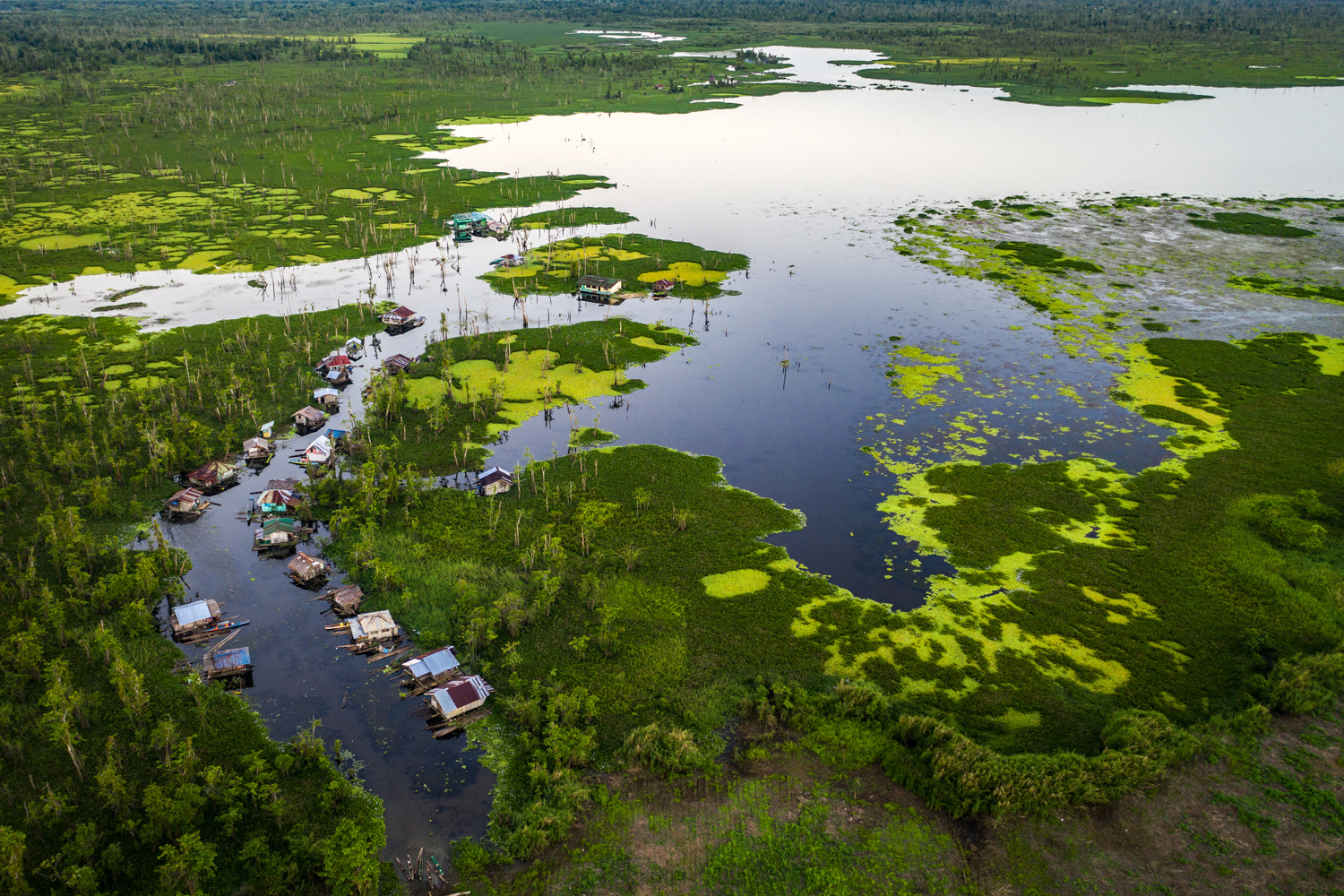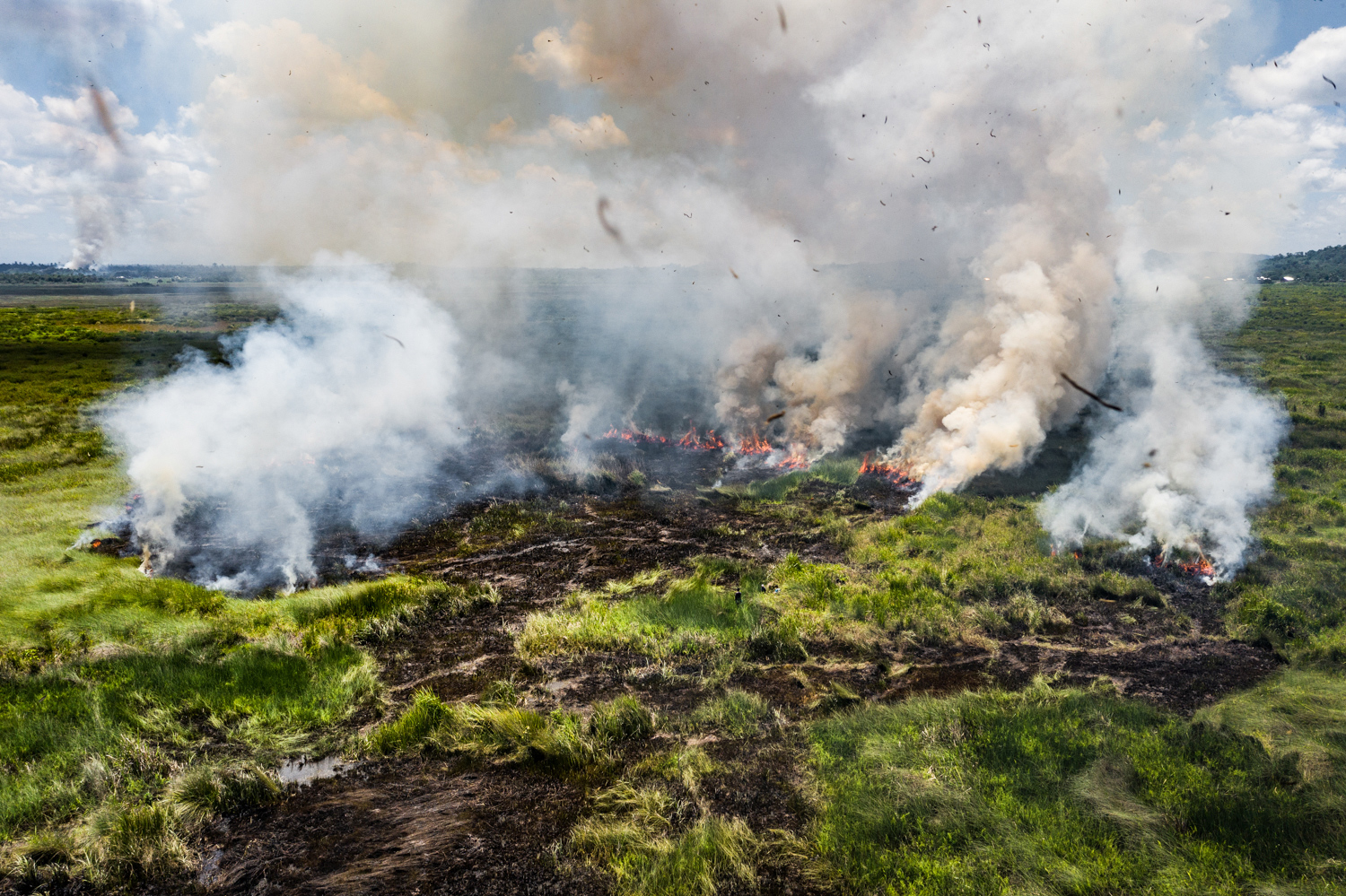- The floating community of the Manobo Indigenous tribe depend on the rise and fall of water in the Philippines’ Agusan Marsh; however, the marsh faces challenges that threaten its ecosystem and the lives of the people who depend on it.
- Development projects, locals and others moving into the fertile region are burning and draining the peatlands and swamp forests for conversion into farmland.
- The continued expansion of agricultural areas in the Agusan Marsh, known as the Philippines’ least-disturbed freshwater wetland, has changed habitats in the basin and, with land use conversion, fragmented ecosystems.
- A recent study published in the journal Nature found extensive global wetland loss over the past three centuries due to various causes, including similar ones seen in the Agusan Marsh.
LOS BAÑOS, Philippines — Built on wooden stilts and tied to endemic bangkal trees (Nauclea orientalis) are the homes of the Manobo Indigenous tribe, seemingly floating on the waters of the largest freshwater wetland in the Philippines: the Agusan Marsh.
The floating village and community depend on the rise and fall of water, being well-adapted to the seemingly never-ending wet season. When the large bay of the marsh fills with water, they use canoes to maneuver from place to place. Their schools, churches and offices are also built on stilts to evade the high water levels. The province where the marsh is located, Agusan del Sur, is a region where there is not truly a “dry season” but a very pronounced wet season with heavy rainfall. Between December and March, the flood waters can go as high as 10 meters (33 feet).
“They are able to commune with the wetlands, they are able to see the wetlands as this being, this deep connection, this deep reverence — even with these [saltwater] crocodiles,” says Gab Meija, a Filipino conservation photographer who has spent years covering the marsh and working in local youth programs.
However, the ecosystems in the marsh face many threats. Community members, large-scale development projects and an increasing outside population lured by the marsh’s fertile soils are burning and draining the peatlands and swamp forests for conversion into farmland. Corn, rice and palm oil plantations are sprouting in their place, as well as infrastructure to irrigate the fields.

The continued expansion of agricultural areas has changed the habitats in the basin and, with land use conversion, interconnectivity is reduced, which is detrimental to biodiversity, says a study published in the International Journal of Development and Sustainability. At the center of this particular threat, state the authors, is the imbalance between food production and biodiversity conservation.
Other pressures arise at the marsh. Electrofishing, which involves placing an electric field in the water to incapacitate fish, is also on the rise and could reduce fish stocks, says Omnia Olama, the regional director of the bureau of fisheries and aquatic resources.
Located in the Philippines, one of the most vulnerable countries in the world to climate change, Agusan Marsh also experiences extreme weather events such as severe typhoons and prolonged droughts that have continuously altered the marsh. The impacts are already being felt today by members of the Manobo community, Meija tells Mongabay.
The Agusan Marsh is not alone. A recent study published in the journal Nature found extensive global wetland loss over the past three centuries caused by similar markers of stress seen in the Philippines’ largest freshwater wetland. The common causes of wetland loss, the study notes, include drainage for upland croplands, conversion to flooded rice fields and peat extraction.
Researchers from Stanford University found that 21% of the 15.8 million square kilometers (6.1 million square miles) of wetlands existing in 1700 are now lost. This is less than the previously reported natural wetland loss of 54-57% since 1700. According to Etienne Fluet-Chouinard, the lead Nature study author, the large gap between the two data estimates primarily comes from differences in methodology.

So far, the Agusan Marsh Wildlife Sanctuary is still the Philippines’ least-disturbed freshwater wetland with a complex network of lakes, rivers, marshes and ponds that hold it all together. It covers an area almost five times the size of Manila at 19,196 hectares (47,434 acres) spanning six municipalities and 38 barangays (a local territorial unit) in the province of Agusan del Sur in northeastern Mindanao. It is home to a vibrantly rich biodiversity that hosts, more or less, 1,100 species of flora and fauna with 314 endemic species recorded.
Wetlands are productive ecosystems that deliver a whole list of functions that are valuable to biodiversity, adaptation and mitigation to climate change, nutrient cycling, erosion control, people’s livelihoods, water and food security and agriculture, among others, says Clarissa Arida, senior director of the programs department of the ASEAN Center for Biodiversity.
“In the ASEAN region, wetland ecosystems are critical habitats for species of birds and mammals, fish, amphibians, shellfish and insects and are rich food sources and breeding grounds for fish,” she says.
Recognizing the importance of the Agusan Marsh, it was declared a Philippine Protected Area in October 1996, has been listed as a Wetland of International Importance under the Ramsar Convention since November 1999 and was declared an ASEAN Heritage Park by the ASEAN Center for Biodiversity in November 2018.

Pressures on the ‘least-disturbed freshwater wetland’
However, these steps have not prevented the threats the marsh currently faces, such as the palm oil plantation developments or putting in place development projects.
According to the SEApeat Project, 4,000 hectares (9,884 acres) of the Agusan Marsh may be declared as “alienable and disposable” for the purposes of irrigation. In the Philippines, alienable and disposable lands are lands in the public domain classified through mapping by the country’s environment department and declared as not needed for forest, mineral purposes or national parks. Agricultural lands that are classified as alienable and disposable may be subject to private ownership.
Contract growing of oil palm has been the trend in Agusan del Sur, particularly in Trento, where palm oil company Agumil Philippines is the major market for the produce. This strategy lures many farmers to convert their underutilized farmlands into oil palm plantations as a get-rich-quick method.
In his years of immersion in the community, Mejia says the other challenges community members have said they face in the Agusan Marsh are droughts and prolonged heat that increase the growth of invasive water hyacinth (Eichornia crassipes) and overtake waterways.
Water hyacinths are free-floating perennial aquatic plants that are native to tropical South America and introduced into the Philippines as an ornamental garden pond plant. Mats of these water hyacinths block waterways and make moving boats around difficult for the floating community as they have to go around the maze of water hyacinths.
“Because of the erratic shifts in weather, everything is changing — their culture, when they need to use their barotos [dugout boats]. There’s these certain influences in their workings that are really changing how the Manobo Indigenous community live,” says Mejia.


According to a 2011 study on the adaptation pathways of the Agusan community, catastrophic floods that bring too much water and too little water or drought are extreme events that undermine the livelihood, health and well-being of the communities.
“They’re very well adapted to even high-level floods. … In floods, they’re capable. They’re really resilient in that sense. But unfortunately, it’s drying up. So that’s the whole takeaway, the difference — the scarcity of water,” Mejia tells Mongabay.
The Nature study notes that even though most previous studies overestimated global wetland conversion by relying on data concentrated in high-loss regions, the study emphasizes the need to urgently restore wetland ecosystems particularly in regions with ongoing rapid drainage.
“The number of benefits provided by wetlands make them among the most economically valuable ecosystems on Earth, from flood protection to biodiversity. Some benefits are local per river basins, like enhanced water quality, while others are global such as carbon sequestration and storage,” Fluet-Chouinard says. “An effective prioritization of wetland conservation and restoration should consider these multiple co-benefits operating at different scales.”
Actions to be taken differ across settings; protection of wetland remnants should be prioritized in regions with large historical losses, then followed by restoration, Fluet-Chouinard tells Mongabay via email. “Regions at the edge of current wetland conversion should find policy mechanisms to halt the drainage and conversion while preserving people’s livelihoods. In regions not directly threatened, preemptive protection would help ensure that wetland soils can continue storing large quantities of carbon for several more millennia.”
Additionally, Meija calls for people to look at these ecosystems in a deeper perspective — that the wetlands aren’t just places you can farm. It’s a source of food, spirituality, love and relational care and livelihood for millions of Filipinos.
“Put [your] eyes in a different gaze to look into the peripheries on what wetlands are and overall, even forests and oceans,” he said. “They are not just ecosystems or places. They’re sources of energy. They’re sources of life.”
Banner image: The Manobo Houses float along the waterways of Lake Panlabuhan in the Agusan Marsh. The wooden houses are tied to locally endemic bangkal trees to keep it from floating away with the currents. Image and caption by Gab Mejia.
A Philippine town and its leaders show how mangrove restoration can succeed
Citations:
Varela, R.P., Fernandez, E.V. and Degamo, J.R.S. (2013), Agricultural Development and Habitat Change in the Agusan River Basin in Mindanao, Philippines. International Journal of Development and Sustainability, Vol. 2 No. 3, pp. 2020-2030.
Fluet-Chouinard, E., Stocker, B. D., Zhang, Z. et al. Extensive global wetland loss over the past three centuries. Nature 614, 281–286 (2023). doi:10.1038/s41586-022-05572-6
Davidson, N. C. (2014). How much wetland has the world lost? long-term and recent trends in global wetland area. Marine and Freshwater Research, 65(10), 934. doi:10.1071/mf14173
Tomas, R. C., Manuta, J. B., & dela Rosa, V. G. (2011). Too Much or Too Little Water: Adaptation Pathways of Agusan Marsh Communities. SLONGAN, 1(1), 14. Retrieved from https://rpo.cjc.edu.ph/index.php/slongan/article/view/2
FEEDBACK: Use this form to send a message to the author of this post. If you want to post a public comment, you can do that at the bottom of the page.
